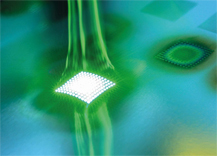
Fraunhofer ILT: The Laser of Tomorrow: Ultra-Fast, Ultra-Precise and Digital
source:optics.org
keywords:
Time:2021-07-15
Aachen, Germany -- The LASER World of PHOTonICS Industry Days took place from June 21 to 24, 2021. With this online event, Messe München – organizer of the world's largest trade show for applied laser technology and photonics – offered its community a high-quality program including market overviews, trend analyses and panel discussions. Industrial laser technology today and tomorrow was one focus of the program.
The photonics industry is weathering Covid-19 and expecting strong growth in 2021
The laser industry has weathered the pandemic surprisingly well. At least that’s what the numbers from analysts at Industry Days say: The market for industrial laser sources grew 2 percent to $4.3 billion in the pandemic year 2020 compared to 2019, noted Dr. Arnold Mayer of Optech Consulting. He saw a 2 percent decline in systems for laser material processing, but expects growth of 12 percent in 2021, when it will reach $19.5 billion.
J?rg Mayer, the managing director of the German industry association SPECTARIS, provided insight into the development of the somewhat broader photonics sector. Around 1000 companies in Germany generated sales of €40.6 billion in this sector in 2020. That was 0.1 percent more than in 2019, and an additional survey revealed that employment rose by 0.5 percent in the process. According to this survey, 9.4 percent growth is expected in 2021, with exports rising by as much as 16 percent.
Photonics is a key technology for Europe as a high-tech location. German industry has been able to establish a leading position in this field through years of investment in research and development. “Maintaining this pole position in the century of the photon is the most important task for politics, business and science,” comments Prof. Constantin H?fner, Director of the Fraunhofer Institute for Laser Technology ILT, on the current state of affairs. In this context, the speakers participating in the panel discussion pointed out the importance of well-trained young photonics professionals. Germany must continue to make targeted investments here.
The laser – the tool of the future
The industrial laser sector today is faced with several challenges – among them, increasing volumes and falling prices. Commoditization is progressing, as Dr. Christian Schmitz from Trumpf also noted. Dr. Markus Kogel-Hollacher of Precitec prefaced his presentation with an important question in this regard: “What to do with all those photons?” As a non-contact and non-abrasive tool, laser beams are available today in a wide variety of forms. Gas, fiber or diode lasers have established themselves in applications such as automotive engineering, the semiconductor industry or metrology. Their performance is growing in line with requirements, as is measurement and process technology. They now enable the large-scale industrial use of lasers far into the kW range.
The laser of the future delivers ultrashort pulses with kW power
A new quality in laser materials processing is expected with the expanded use of ultrashort pulsed lasers. They promise precision down to the sub-micron range and can process even the hardest materials thanks to their non-linear interaction. This makes them incredibly versatile for materials processing and the ultimate tool for digital photonic production.
However, ultrashort pulse (USP) lasers have lacked the necessary average power and industrial robustness for high-throughput applications. This technical bottleneck has been overcome by the USP lasers developed within the Fraunhofer Cluster of Excellence Advanced Photon Sources CAPS – up to 10 kW average power has been demonstrated. As a consequence of these world-record powers, massive parallel processing is becoming possible. The necessary technology is currently being tested on a wide range of applications in two application laboratories in Jena and Aachen.
Modern production requires flexibility and agility and, therefore, is focused on the process rather than the product. Digital Photonic Production is the enabler to accomplish this – it builds the bridge from the virtual development environment to the production world.
In this context, research is increasingly focusing on the efficient use of machine learning and AI to accelerate process adaptation and shorten the time-to-market. In the future, processes will need to adapt more quickly to cost, regulatory or sustainability drivers.
“Tomorrow's competitive advantage will be the effective use of digital data in production environments,” says Prof. H?fner, describing a trend that is also changing laser technology.
The LASER World of PHOTonICS Industry Days were attended by more than 1500 participants. The online event was closely interlinked with the World of PHOTonICS Congress, in which around 2450 scientists participated online.

Pictured above: USP lasers with kW power are being developed in the Fraunhofer Cluster of Excellence CAPS for precise, scalable and digitally controllable material processing. Image: Fraunhofer ILT.
- RoboSense is to Produce the First Chinese Multi-beam LiDAR
- China is to Accelerate the Development of Laser Hardening Application
- Han’s Laser Buys Canadian Fiber Specialist CorActive
- SPI Lasers continues it expansion in China, appointing a dedicated Sales Director
- Laser Coating Removal Robot for Aircraft
 FISBA exhibits Customized Solutions for Minimally Invasive Medical Endoscopic Devices at COMPAMED in
FISBA exhibits Customized Solutions for Minimally Invasive Medical Endoscopic Devices at COMPAMED in New Active Alignment System for the Coupling of Photonic Structures to Fiber Arrays
New Active Alignment System for the Coupling of Photonic Structures to Fiber Arrays A new industrial compression module by Amplitude
A new industrial compression module by Amplitude Menhir Photonics Introduces the MENHIR-1550 The Industry's First Turnkey Femtosecond Laser of
Menhir Photonics Introduces the MENHIR-1550 The Industry's First Turnkey Femtosecond Laser of Shenzhen DNE Laser introduced new generation D-FAST cutting machine (12000 W)
more>>
Shenzhen DNE Laser introduced new generation D-FAST cutting machine (12000 W)
more>>
